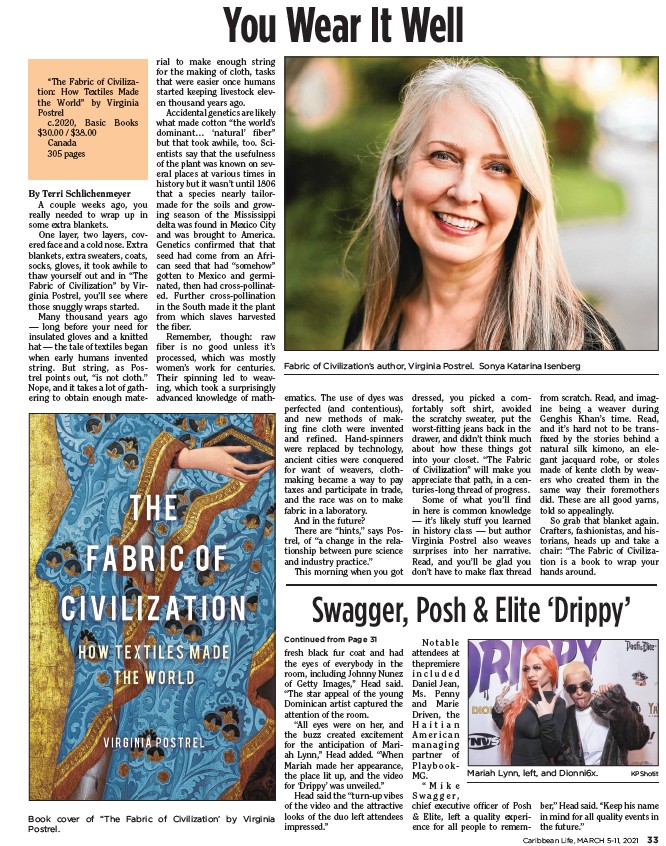
Swagger, Posh & Elite ‘Drippy’
Caribbean Life, MARCH 5-11, 2021 33
By Terri Schlichenmeyer
A couple weeks ago, you
really needed to wrap up in
some extra blankets.
One layer, two layers, covered
face and a cold nose. Extra
blankets, extra sweaters, coats,
socks, gloves, it took awhile to
thaw yourself out and in “The
Fabric of Civilization” by Virginia
Postrel, you’ll see where
those snuggly wraps started.
Many thousand years ago
— long before your need for
insulated gloves and a knitted
hat — the tale of textiles began
when early humans invented
string. But string, as Postrel
points out, “is not cloth.”
Nope, and it takes a lot of gathering
to obtain enough material
You Wear It Well
to make enough string
for the making of cloth, tasks
that were easier once humans
started keeping livestock eleven
thousand years ago.
Accidental genetics are likely
what made cotton “the world’s
dominant… ‘natural’ fiber”
but that took awhile, too. Scientists
say that the usefulness
of the plant was known on several
places at various times in
history but it wasn’t until 1806
that a species nearly tailormade
for the soils and growing
season of the Mississippi
delta was found in Mexico City
and was brought to America.
Genetics confirmed that that
seed had come from an African
seed that had “somehow”
gotten to Mexico and germinated,
then had cross-pollinated.
Further cross-pollination
in the South made it the plant
from which slaves harvested
the fiber.
Remember, though: raw
fiber is no good unless it’s
processed, which was mostly
women’s work for centuries.
Their spinning led to weaving,
which took a surprisingly
advanced knowledge of math- ematics. The use of dyes was
Book cover of “The Fabric of Civilization’ by Virginia
Postrel.
perfected (and contentious),
and new methods of making
fine cloth were invented
and refined. Hand-spinners
were replaced by technology,
ancient cities were conquered
for want of weavers, clothmaking
became a way to pay
taxes and participate in trade,
and the race was on to make
fabric in a laboratory.
And in the future?
There are “hints,” says Postrel,
of “a change in the relationship
between pure science
and industry practice.”
This morning when you got
dressed, you picked a comfortably
soft shirt, avoided
the scratchy sweater, put the
worst-fitting jeans back in the
drawer, and didn’t think much
about how these things got
into your closet. “The Fabric
of Civilization” will make you
appreciate that path, in a centuries
long thread of progress.
Some of what you’ll find
in here is common knowledge
— it’s likely stuff you learned
in history class — but author
Virginia Postrel also weaves
surprises into her narrative.
Read, and you’ll be glad you
don’t have to make flax thread
from scratch. Read, and imagine
being a weaver during
Genghis Khan’s time. Read,
and it’s hard not to be transfixed
by the stories behind a
natural silk kimono, an elegant
jacquard robe, or stoles
made of kente cloth by weavers
who created them in the
same way their foremothers
did. These are all good yarns,
told so appealingly.
So grab that blanket again.
Crafters, fashionistas, and historians,
heads up and take a
chair: “The Fabric of Civilization
is a book to wrap your
hands around.
“The Fabric of Civilization:
How Textiles Made
the World” by Virginia
Postrel
c.2020, Basic Books
$30.00 / $38.00
Canada
305 pages
Fabric of Civilization’s author, Virginia Postrel. Sonya Katarina Isenberg
fresh black fur coat and had
the eyes of everybody in the
room, including Johnny Nunez
of Getty Images,” Head said.
“The star appeal of the young
Dominican artist captured the
attention of the room.
“All eyes were on her, and
the buzz created excitement
for the anticipation of Mariah
Lynn,” Head added. “When
Mariah made her appearance,
the place lit up, and the video
for ‘Drippy’ was unveiled.”
Head said the “turn-up vibes
of the video and the attractive
looks of the duo left attendees
impressed.”
Not able
attendees at
the premiere
i n c l u d e d
Daniel Jean,
Ms. Penny
and Marie
Driven, the
H a i t i a n
Amer ic an
managing
partner of
Playbook-
MG.
“ M i k e
S w a g g e r,
chief executive officer of Posh
& Elite, left a quality experience
for all people to remember,”
Head said. “Keep his name
in mind for all quality events in
the future.”
Continued from Page 31
Mariah Lynn, left, and Dionni6x. KPShotit